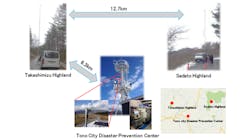The TV white-space spectrum has proven that it can increase broadband-communication services in difficult areas. Yet it has not been fully vetted for long-range communications. When an unlicensed portion of radio spectrum with a low probability of interference is used on existing infrastructures, the lower frequency (470 to 710 MHz in Japan) typically has a low impact on distance decay (compared to higher-frequency legacy systems). Recently, a long-range broadband-communications field trial in Japan’s TV white space was completed using IEEE 802.22- and 802.11af-based systems.
The IEEE 802.22 standard for wireless regional-area networks (WRANs) covers a radius of 10 to 40 km for rural-area broadband service. The IEEE 802.11af standard, in contrast, specifically targets white-space operation. In this demonstration, a multihop network was constructed using an IEEE 802.22 backbone link. That link was connected to an IEEE 802.11af wireless link, thereby expanding the connection area. The multihop configuration uses a relay terminal to connect terminals that cannot directly transmit on their own. A wireless local-area network (WLAN), based on conventional IEEE 802.11b/g/n in the 2.4-GHz band, was attached to the IEEE 802.11af link. It allowed off-the-shelf devices to access the network’s connection.
The trial was performed in Tono City, Iwate Prefecture, Japan by the National Institute of Information and Communications Technology (NICT) and Hitachi Kokusai Electric. It showed successful downstream and upstream data transmission—at speeds of 5.2 Mb/s and 4.5 Mb/s, respectively—at a distance of 12.7 km between an IEEE 802.22-based base station and customer premise equipment (CPE). With its potential to bring broadband service to rural areas, this technology could be especially useful in supporting communications during disasters. The multihop configuration provides flexible network construction, allowing for different link specifications according to given distances and transmission speeds. Applications include video monitoring of roads and cliffs and video-phone capabilities in mountainous areas, where network connections are either limited or completely unavailable.
This file type includes high resolution graphics and schematics when applicable.


